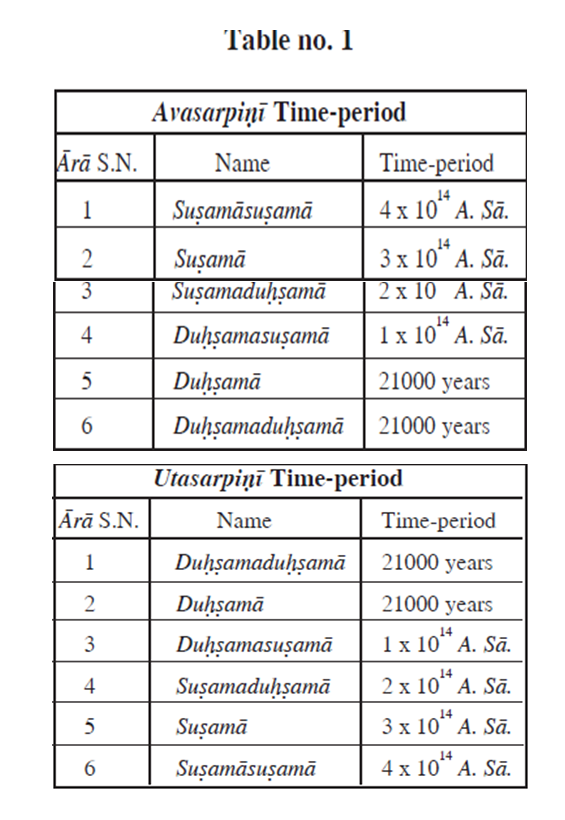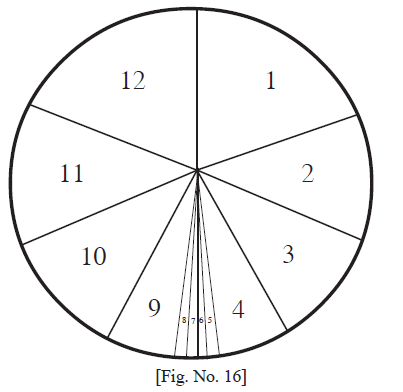The exposition of eternity and non-eternity made so far is from the view-point of the whole universe. However, situated in the central part of the universe is 'tiryaga loka' and Jain philosophy accepts the principle of kāla-cakra (time-cycle)- avasarpiṇī (descending) and utsarpiṇī (ascending) for specific regions of this tiryaga loka. In the discussion of the universe with respect to space, it was indicated that the universe as a whole is 14 rajjus in height, adholoka (lower universe) is a little more than 7 rajjus in height and ūrdhva loka (upper universe) is a little less than 7 rajjus in height. In between these two is situated the tiryag loka with height of merely 1800 yojanas and length and breadth of one rajju. In tiryaga loka,[1] innumerable continents and oceans are situated in the form of concentric rings. Out of these, Jambūdvīpa, Lavaṇa ocean, Dhātakī continent, Kalodadhi continent and half of the Puṣkaradvīpa are located in the central rings. This particular region is known as kāla-kṣetra (time-zone). It is only in this region of kāla-kṣetra that time, based on motions of sun and moon, exists.
Some basic natural phenomena undergo changes with the flow of time. These changes are explained with the principle of avasarpiṇī and utsarpiṇī. Avasarpiṇī and utsarpiṇī are halves of a complete time-cycle which is a well-defined time-cycle of evolution and degeneration.
One time-cycle is completed in 20 koṭākoṭi (20x1014) addhā sāgaropama.[2] It takes innumerable years[3] for this time to elapse.[4]
Each cycle has two halves-one of avasarpiṇī and the other of utsarpiṇī. In half cycle of avasarpiṇī, nature gradually undergoes degeneration and in the following half cycle of utsarpiṇī, the nature undergoes evolution. In utsarpiṇī half cycle, there is gradual winding up of the universe at a very slow rate until a state of the highest organization is reached. After this, there is again unwinding of universe, in which universe runs down until a state of the lowest dissolution is reached. While defining avasarpiṇī and utsarpiṇī, it is said that[5] "that half time-cycle in which śubha bhāva (auspicious aspects) gradually decline and aśubha bhāva (inauspicious aspects) gradually increase is avasarpiṇī. That half time-cycle in which śubha bhava gradually increase and aśubha bhāva gradually decline is utsarpiṇī." During avasarpiṇī, attributes of pudgalas (atoms as well as aggregates of atoms) like taste, color, touch, smell etc. undergo declination of infinite number of units.[6] In utsarpiṇī it is the reverse of this. After the end of the avasarpiṇī ensues utsarpiṇī and after the end of the utsarpiṇī ensues avasarpiṇī and so on the cycle continues. In the infinite past, infinite number of time-cycles have taken place and in the infinite future, infinite number of time-cycles will take place. Each half time-cycle which is of 10 koṭākoṭi sāgaropama is divided into six parts. Each part is called 'ārā' (see figure 16 on page no. 176).


The name of each ārā and and its time-period is given in the table.[7]
The detailed description of stage by stage evolution and degeneration is available in Jain Āgamas (scriptures). Here, while not giving detailed description, we will illustrate their evolution and degradation through three processes. In avasarpiṇī, with the passing of time, life-span, height and number of vertebra in the backbone decrease. The maximum life-span of those human beings born in beginning of avasarpiṇī is three palyopamas. Those born later have lesser life-span. This way gradually decreasing, in the beginning of second ārā, the life-span becomes two palyopamas. Similarly the height and number of vertebra also gradually decrease. This decline is tabulated as follows:
Table No. 2
| Ārā S.N | Āyuṣya Āyuṣya (life-span) | Height | Number of Vertebra |
| 1 | 3 Palyopamas | 6000 Dhanuṣyas | 256 |
| 2 | 2 " | 4000 " | 128 |
| 3 | 1 " | 2000 " | 64 |
| 4 | 1 Crore Pūrvas | 500[8] | 48 |
| 5 | 130 years | 7 Hāthas | 24 |
| 6 | 20 years | 1[9] | 12 |
In utsarpiṇī, life-span, height and number of vertebra gradually go on increasing.
In both Shvetambara and Digambara traditions, one addhā sāgaropama is equal to asaṃkhyāta (innumerable) years. In the Digambara tradition, the period of one complete time-cycle is also called one kalpa (or mahākalpa). (SeeTiloyapaṇṇatte, 4.316).
According to Prof. G. R. Jain, 'The biggest unit of time is the Mahākalpa made up of two aeons, avasarpiṇī and utsarpiṇī, each consisting of
41345263030820317774951219200000000000000000000000000000000000000000000000000 (77 digits) solar years. (The Brahma kalpa of Hindus also cosists of 77 digits but the digits do not agree).'
It means-
1 Mahākalpa = 8.25 x 1076 years
But if we compare this number, it is much less than the number of asaṃkhyāta years. Even, in the Digambara tradition the highest numerable time-unit is called acalātma.
1 Acalātma = 8431 x 1090 years
= 4.5 x 10149 years approximately.
See, for the time-units of both traditions, Appendix II, infra pp. 341-353.
Yasyāṃ sarve śubhā bhāvāḥ kṣīyante'nukṣaṇaṃ kramāt.
Aśubhāśca pravardhante, sā bhavatyavasarpiṇī..
Śubhā bhāvā vivarddhante kramādyasyāṃ pratikṣaṇaṃ.
Hīyante cāśubhā bhāvā bhavatyutsarpiṇīti sā.. - Lokaprakāśa, 29-44, 45.
Aṇaṃtehiṃ vaṇṇapajjavehiṃ gaṃdhapajjavehiṃ, yāvatparihāyamāṇehi
omappiṇī paḍivajjaī. - Jaṃbūdvīpaprajapti Sūtra, Kālādhikāra.
 Prof. Muni Mahendra Kumar
Prof. Muni Mahendra Kumar

